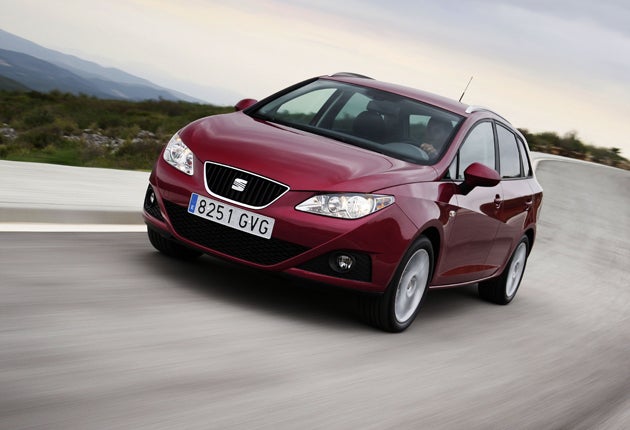Seat Ibiza ST
Seat hopes its new estate is a little bit Lamborghini

Your support helps us to tell the story
From reproductive rights to climate change to Big Tech, The Independent is on the ground when the story is developing. Whether it's investigating the financials of Elon Musk's pro-Trump PAC or producing our latest documentary, 'The A Word', which shines a light on the American women fighting for reproductive rights, we know how important it is to parse out the facts from the messaging.
At such a critical moment in US history, we need reporters on the ground. Your donation allows us to keep sending journalists to speak to both sides of the story.
The Independent is trusted by Americans across the entire political spectrum. And unlike many other quality news outlets, we choose not to lock Americans out of our reporting and analysis with paywalls. We believe quality journalism should be available to everyone, paid for by those who can afford it.
Your support makes all the difference.The car you see here was shaped by a man who used to style Lamborghinis. That is a bit of a mental stretch, but at least the two companies occupy opposite ends of the same Volkswagen group.
Luc Donckerwolke has done some good designs, actually. But the problem with applying swathes of visual sportification to something as humble as an estate car based on a small hatchback is that, sometimes, the basic shape can't stand the decoration.
Seat is touting the new Ibiza ST – it stands for Sports Tourer – as the most stylish small estate car on the planet. Let's just say that its stylishness is very dependent upon the angle from which it is viewed. In profile it simply looks over-bodied, the excessively long front overhang, common to all current Ibizas now matched by bulk at the rear, given that the ST is 180mm longer than the regular Ibiza hatchback.
But Seat doesn't make the crash-test rules which force this visual disproportion. It's just that the ST's shape doesn't hide their effect very well. What the shape does do, though, is convert the Ibiza idea into quite a good load-carrier thanks to the extra 138 litres of load space. And it's not as if its supermini-estate rivals are any more elegant. Perhaps, out of a rather awkward-looking bunch, the ST is indeed the most handsome.
In their more fanciful moments, Seat's marketing people see the Ibiza ST as a good-value alternative to an Audi A3 Sportback, but that is stretching a point. For under its too-long nose the ST has much more modest engines.
The Volkswagen group has long championed the idea of a small, three-cylinder turbodiesel, and this latest one has shrunk from 1.4 to 1.2 litres. It produces 74bhp and, in the imminent Ecomotive version, just 94g/km of CO2 thanks to a stop-start system and the ability to recover electrical energy when slowing or braking. That makes it a sort of very mild hybrid, except that the recovered energy powers the car's electrical systems rather than a motor.
A similar system is attached to the other new-to-Ibiza engine, the 1.2 TSI petrol turbo engine, which is significantly more economical than the older, non-turbo, 1.4-litre unit despite producing 105bhp against 85. The TSI can also be had with a seven-speed, double-clutch DSG transmission.
Both new engines are pleasing. The little turbodiesel's deep hum is an unusual noise which some might not like (I do), and it's a willing unit if not exactly energetic, so you don't suffer too much for your greenness. The TSI is much livelier, as you would expect, with keen acceleration, good pull from low speeds and a crisp response to the accelerator. A 1.6-litre turbodiesel is also offered, with the same power as the 1.2 TSI and only slightly better CO2 output (112g/km against 119).
Today's Seats are much more supple over bumps than some of their predecessors, which were forced to bear an artificially "sporty" mantle to no useful end. Yet they are still good fun for a keen driver, with precise, consistent steering and a handling balance just right for threading through a series of bends. The top Sport versions of the ST have stiffer rear suspension, but there's little gain in agility and the ride comfort suffers a little. The cheaper S and SE versions are a better compromise.
Inside, the Ibiza's relative cheapness – prices range from £12,070 to £14,910 – shows in some hard trim plastics, most tellingly in the rear door panels. More fundamental a problem, though, is the very part of the ST that is supposed to make it a practical estate car: the way the rear seats fold.
The rear seat cushions flip forward, on wobbly steel rods, to make space for the backrests to fold down behind them, but this can happen only if the front seats are quite a long way forward. A tall driver would then be left with insufficient room. And even with the seats successfully folded, there's still a step down to the boot floor instead of a flat, continuous load bay. There is a useful hidden rear shelf under the main one, though.
So: stylish? Up to a point. Practical? Not entirely. Frugal? Remarkably so. Genuinely fun to drive? Absolutely. For that I can forgive the Ibiza ST a lot.
The Rivals
Peugeot 207 SW 1.4 : from £13,835
Rear window styling is awkward, pace and economy are nothing special (95bhp, 140g/km). Otherwise a roomy, well-thought-out estate car.
Renault Clio Sport Tourer 1.2 TCe 100 Expression: from £12,942
Similar shape but less panache. Downsized turbo engine manages 100bhp and 137g/km. No air-con at entry-level.
Skoda Fabia estate 1.2 TSI: from £12,375
A great estate and pleasing to drive. Same 1.2 TSI engine as Seat, here rated 124g/km. Entry model has DSG but no air-con.
Join our commenting forum
Join thought-provoking conversations, follow other Independent readers and see their replies
Comments